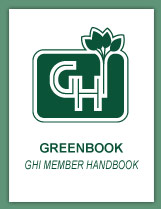X.L. Impervious Surface Rules
- Purpose
- Part of GHI’s mission is to maintain, protect and enhance the assets of our cooperative. One of these assets is green space, including swales. GHI encourages members to keep their yards in their natural condition as much as possible. This is consistent with the original design of Greenbelt as a garden city. Swales are part of the original design of GHI and are a natural way to control runoff and promote drainage. The impervious surface rules herein do not limit the use of fully permeable green space, such as gardens planted with trees, shrubs, and herbaceous plants.
- The impervious surface rules herein are intended to help maintain the benefits of natural landscaping by limiting the amount of impervious surface in GHI yards and requiring use of permeable materials. These rules are intended to address increased stormwater runoff, reduce or prevent flooding in GHI, and reduce negative effects on area streams. Limiting the amount of impervious surface area in GHI also helps Prince Georges County meet its requirement to reduce pollution and flooding caused by rainfall.
- Rules
- Any new exterior surface structures (meaning those partially or totally outside of the Member’s unit’s indoor livable space) such as decks, patios, and walkways, other than the access walkways, must be constructed using pervious materials.
- Exterior surface structures may not be constructed with impervious materials such as concrete, asphalt, or non-porous composite or conglomerate materials.
- Use of porous asphalt in GHI yards is not allowed.
- Exterior elevated structures, such as decks and porches, may contain concrete pylons in their design.
- The flooring of exterior elevated structures may be constructed with impervious natural or composite materials so long as there are gaps in the flooring that will allow water to drain.
- Multiple allowable semi-pervious materials are described in Sections E and F below.
- Semi-pervious surfaces such as patios and decks may cover a single contiguous area up to a maximum area of 250 sq ft or 20% of the pervious gross yard area (serviceside+gardenside+endside [if applicable]), whichever value is smaller, or multiple distinct areas totaling no more than 250 sq ft. or 20% of the pervious gross yard area, whichever value is smaller.
- As stated in Sections III.B.11 and IV.E of this Handbook, existing swales shall not be blocked by any structure or altered in any way by a Member that would compromise the functioning of the swale.
- As stated in Section X.I of this Handbook, structures may not be built over buried utilities. Permission to build a structure is contingent on the determination that no buried utilities are located where the new structure is to be built.
- Wheelchair ramps and other means of accessibility for disabled individuals are addressed separately from these rules in GHI’s the Reasonable Accommodation Policy.
- Walkways maintained and/or replaced by GHI do not count against the total maximum allowable square footage noted in this rule.
- Definitions for the terms used in these rules are provided in Section D below.
- Any new exterior surface structures (meaning those partially or totally outside of the Member’s unit’s indoor livable space) such as decks, patios, and walkways, other than the access walkways, must be constructed using pervious materials.
- Background
- The amount of existing impervious surfaces in and around GHI increases the impact and frequency of flooding events, including damage to GHI member homes and erosion of paths and common areas.
- Installing new impervious surfaces reduces the area of land available for rainwater to soak into the ground as well as reducing the area of land that can support trees, woody plants, shrubs, grasses or other types of vegetation (e.g., gardens). Trees and other vegetation help reduce the amount of stormwater runoff by trapping silt and sediment, stabilizing areas susceptible to erosion, increasing infiltration, and reducing surface runoff. By contrast, impervious surfaces increase the speed and amount of stormwater runoff and, therefore, increase erosion. Additional runoff from impervious surfaces can overload the capacity of streams and storm drains. This runoff also picks up and carries pollutants into storm drains that flow into GHI streams Greenbelt Lake, and ultimately into the Anacostia River and Chesapeake Bay, degrading the water quality in these waterways.
- Definitions
- Impervious surface: a hard surface area that prevents or substantially impedes the natural infiltration of water into the underlying soil, resulting in an increased volume and velocity of surface water runoff. Impervious surfaces include, but are not limited to, buildings; patios, decks, sidewalks, driveways, pavement, parking areas, and driveways constructed of concrete or asphalt; artificial turf, compacted gravel, and hard-surfaced recreational areas (e.g., tennis courts).
- Pervious surface: a surface that allows water to percolate into the underlying soil. Pervious surfaces include grass, mulch, natural forest, and gardens planted with trees, shrubs, and herbaceous plants
- Semi-pervious surface: a surface that allows water to percolate into the underlying soil, but to a lesser degree than a pervious surface. Semi-pervious surfaces include vegetated roofs, permeable paving, and porches and decks erected on pier foundations that maintain the covered surface’s water permeability (coz.dc.gov/zoning-rules/general-rules/pervious-surfaces/)
- Swales. Swales are depressed channels designed to move stormwater while slowing down stormwater runoff and removing pollutants.
- Compacted cover - An area of land where water percolation is reduced by increased compaction of the soil as compared to undisturbed areas (e.g., forest, meadow). Soil compaction occurs from grading, regular foot or vehicle traffic, or regular pet use (e.g., a dog run).
- Erosion - The process by which soil, mulch, etc. is worn away by the action of water
- Runoff - That portion of rain and/or snow melt that travels over the land surface, rooftops, sidewalks, roads, patios, etc.
- Stormwater – The flow of water that results from rain and/or snow melt runoff, street runoff, and land surface (e.g., yards, common areas) runoff and drainage.
- Structure – For the purposes of this rule, a structure means an object such as a building, that has been built principally above ground with a fixed location on the ground but is not necessarily fully enclosed. Structures for the purposes of this rule do not include additions, sheds, or landscaping that utilizes landscaping rocks or mulch (see Section F below).
- Allowable Permeable Materials
- Allowable surface and elevated structure materials consist of permeable pavers, bricks with sand filler; permeable pavement; tamped gravel; and wooden, composite, or plastic boards.
- Light colored permeable materials are preferred to increase the reflection of sunlight and reduce the urban heat island effect.
- Permeable Pavers
- Permeable pavers are a self-draining system that allows rainwater to seep around individual pavers, soaking naturally into the subbase and ground underneath as indicated in the figure below. Source: City of Portland 2020 Stormwater Management Manual, December 2020, Figure SW-110
- Permeable pavers can create a longer-lasting surface compared with conventional concrete and can reduce flooding on your property or the surrounding area.
- Permeable pavers and re-vegetation:
- Reduce flooding and erosion caused by stormwater runoff
- Promote groundwater recharge, increasing both the quantity and quality of water
- Permeable pavers are a self-draining system that allows rainwater to seep around individual pavers, soaking naturally into the subbase and ground underneath as indicated in the figure below.
- Bricks with Sand
- Like permeable pavers, bricks with sand allow rainwater to seep around the bricks and can reduce flooding and erosion caused by stormwater runoff.
- Water flow in brick and sand systems is like that shown above for permeable paver systems.
- Pervious Concrete
- Pervious concrete allows water to filter through the pavement structure into underlying layers and eventually to the soil.
- Water flows through the pervious concrete system as shown in the figure below. Source: City of Portland 2020 Stormwater Management Manual, December 2020, Figure SW-110
- Permeable concrete does require some maintenance to retain its permeability.
- Wooden, Composite, or Recycled Plastic Boards
- Boards used for decking and porch flooring typically have spaces between them, allowing water to flow between the boards to the underlying soil.
- Composite boards are made from a mix of wood particles and durable synthetic materials and come in many colors.
- Recycled plastic boards mimic wood using recycled plastic and come in many colors.
- Landscaping Rocks
- Although landscaping rocks are not considered a structure for the purposes of this rule, the use of light-colored materials is preferred to reduce the urban heat island effect.
- Landscaping rocks consist of pea gravel, gravel, crushed stone, river rocks, flagstones (but not flagstones set in concrete), and decomposed granite. Due to their shapes, landscaping rocks allow water to filter down into the underlying soil.
- Rain Check Rebate Program
- The Prince Georges County Rain Check Rebate Program allows GHI Members to receive rebates for installing ‘Rain Check’ approved practices that reduce stormwater runoff quantity. These practices include permeable pavers, permeable pavement, pavement removal, and tree canopy.
- Members are encouraged to take advantage of this program as long as it is available to defray costs and decrease stormwater runoff.
- More information on the Program can be found at https://cbtrust.org/grants/prince-georges-county-rain-check-rebate/.




